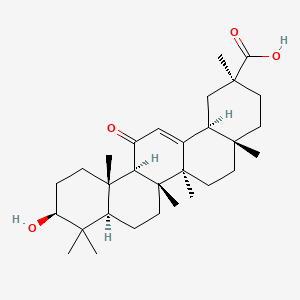| Authors | Title | Published | Journal | PubMed Link |
|---|---|---|---|---|
| Ransjö M et al. | Expression of connexin 43 mRNA in microisolated murine osteoclasts and regulation of bone resorption in vitro by gap junction inhibitors. | 2003 | Biochem. Biophys. Res. Commun. | pmid:12684060 |
| El-Sabban ME et al. | ECM-induced gap junctional communication enhances mammary epithelial cell differentiation. | 2003 | J. Cell. Sci. | pmid:12893812 |
| Ye ZC et al. | Functional hemichannels in astrocytes: a novel mechanism of glutamate release. | 2003 | J. Neurosci. | pmid:12736329 |
| Solomon IC et al. | Blockade of brain stem gap junctions increases phrenic burst frequency and reduces phrenic burst synchronization in adult rat. | 2003 | J. Neurophysiol. | pmid:12522166 |
| Sung YJ et al. | Intercellular calcium waves mediate preferential cell growth toward the wound edge in polarized hepatic cells. | 2003 | Exp. Cell Res. | pmid:12837277 |
| Guillotin B et al. | Human primary endothelial cells stimulate human osteoprogenitor cell differentiation. | 2004 | Cell. Physiol. Biochem. | pmid:15319536 |
| Seul KH et al. | Adenoviral delivery of human connexin37 induces endothelial cell death through apoptosis. | 2004 | Biochem. Biophys. Res. Commun. | pmid:15194487 |
| De Blasio BF et al. | Global, synchronous oscillations in cytosolic calcium and adherence in bradykinin-stimulated Madin-Darby canine kidney cells. | 2004 | Acta Physiol. Scand. | pmid:15030375 |
| Fujino H and Regan JW | Prostaglandin F2alpha amplifies tumor necrosis factor-alpha promoter activity by the FPB prostanoid receptor. | 2004 | Biochem. Biophys. Res. Commun. | pmid:15094384 |
| Thust R et al. | Cytogenetic detection of a trans-species bystander effect: induction of sister chromatid exchanges in murine 3T3 cells by ganciclovir metabolized in HSV thymidine kinase gene-transfected Chinese hamster ovary cells. | 2004 | Mutagenesis | pmid:14681310 |
| Garg S et al. | Staphylococcus aureus-derived peptidoglycan induces Cx43 expression and functional gap junction intercellular communication in microglia. | 2005 | J. Neurochem. | pmid:16190870 |
| Gumpricht E et al. | Licorice compounds glycyrrhizin and 18beta-glycyrrhetinic acid are potent modulators of bile acid-induced cytotoxicity in rat hepatocytes. | 2005 | J. Biol. Chem. | pmid:15642733 |
| Shamekh R et al. | The role of connexins in the differentiation of NT2 cells in Sertoli-NT2 cell tissue constructs grown in the rotating wall bioreactor. | 2006 | Exp Brain Res | pmid:16328273 |
| Miyazato M et al. | A gap junction blocker inhibits isolated whole bladder activity in normal rats and rats with partial bladder outlet obstruction. | 2006 | Biomed. Res. | pmid:17099284 |
| Perez Velazquez JL et al. | Role of gap junctional coupling in astrocytic networks in the determination of global ischaemia-induced oxidative stress and hippocampal damage. | 2006 | Eur. J. Neurosci. | pmid:16420410 |
| Luna VM and Brehm P | An electrically coupled network of skeletal muscle in zebrafish distributes synaptic current. | 2006 | J. Gen. Physiol. | pmid:16801383 |
| Kamijo M et al. | The function of connexin 43 on the differentiation of rat bone marrow cells in culture. | 2006 | Biomed. Res. | pmid:17213685 |
| RodrÃguez-Sinovas A et al. | Protective effect of gap junction uncouplers given during hypoxia against reoxygenation injury in isolated rat hearts. | 2006 | Am. J. Physiol. Heart Circ. Physiol. | pmid:16183732 |
| Guan BC et al. | Blockade of gap junction coupling by glycyrrhetinic acids in guinea pig cochlear artery: a whole-cell voltage- and current-clamp study. | 2007 | Br. J. Pharmacol. | pmid:17572704 |
| Lin D et al. | Protein kinase C gamma mutations in the C1B domain cause caspase-3-linked apoptosis in lens epithelial cells through gap junctions. | 2007 | Exp. Eye Res. | pmid:17493614 |
18alpha-glycyrrhetinic acid
18alpha-glycyrrhetinic acid is a lipid of Prenol Lipids (PR) class. 18alpha-glycyrrhetinic acid is associated with abnormalities such as Wiskott-Aldrich Syndrome. The involved functions are known as inhibitors, salivary gland development and branching morphogenesis.
Cross Reference
Introduction
To understand associated biological information of 18alpha-glycyrrhetinic acid, we collected biological information of abnormalities, associated pathways, cellular/molecular locations, biological functions, related genes/proteins, lipids and common seen animal/experimental models with organized paragraphs from literatures.
What diseases are associated with 18alpha-glycyrrhetinic acid?
18alpha-glycyrrhetinic acid is suspected in and other diseases in descending order of the highest number of associated sentences.
Related references are mostly published in these journals:
| Disease | Cross reference | Weighted score | Related literature |
|---|
No disease MeSH terms mapped to the current reference collection.
PubChem Associated disorders and diseases
What pathways are associated with 18alpha-glycyrrhetinic acid
There are no associated biomedical information in the current reference collection.
PubChem Biomolecular Interactions and Pathways
Link to PubChem Biomolecular Interactions and PathwaysWhat cellular locations are associated with 18alpha-glycyrrhetinic acid?
There are no associated biomedical information in the current reference collection.
What functions are associated with 18alpha-glycyrrhetinic acid?
Related references are published most in these journals:
| Function | Cross reference | Weighted score | Related literatures |
|---|
What lipids are associated with 18alpha-glycyrrhetinic acid?
There are no associated biomedical information in the current reference collection.
What genes are associated with 18alpha-glycyrrhetinic acid?
There are no associated biomedical information in the current reference collection.
What common seen animal models are associated with 18alpha-glycyrrhetinic acid?
There are no associated biomedical information in the current reference collection.
